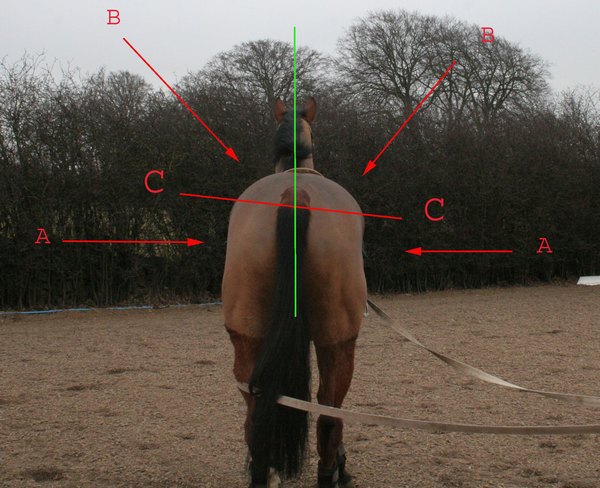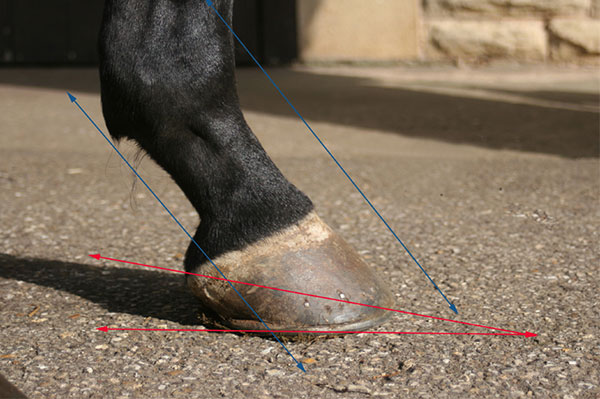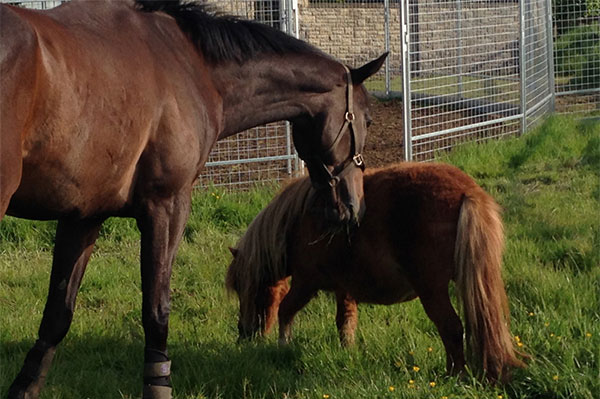For the purpose of these articles you are reminded that the horse is straight out of training. This article provides a guide as to what to expect and what to do when your horse first arrives.
So you have bitten the bullet and made the decision to re-home a racehorse, made your choice and he is due to arrive. Whilst the arrival of a new horse is exciting, there is also an element of trepidation as it is a step into the unknown; retraining is an adventure, a journey, with twists and turns and ups and downs – and quite possibly more downs that ups to start with, but it is great journey along which you will learn so much.
For the horse coming out of training, his move from the racing environment is a life-changing event. In the human world, it is readily acknowledged that moving house is one of the most stressful experiences of life; so much as we should not anthropomorphise animals as the experience is no less of an event for a horse. The day he steps onto the lorry to leave the trainer, is the day his world is tipped upside down so be prepared that your new charge may behave a little differently than everyone at the racing yard advised.
The very event of moving can be enough to trigger some form of stereotypical behaviour that a horse genuinely did not present whilst in training, so it is not necessarily the case that the presence of a ‘vice’ was not disclosed to you. However once he begins to settle in and adapt to a new lifestyle, any adverse demonstrations usually disappear.
On arrival
Knowing your new charge is due to arrive, you should have everything in hand so that his general health and condition can be assessed – so this is a visit from an EDT not only to check the teeth are in good order but also that jaw action and grinding mechanism are functioning correctly; horses grind their teeth in a figure-of-eight fashion so they must be able to move the jaw to the left and right without restriction. Issues with jaw function, in particular the temporomandibular (TMJ) joint can lay behind biting and performance issues.
A practitioner trained in chiropractic should check the skeletal aspects to make sure everything is correctly aligned. It may be on the day of the assessment your horse presents unsound, but this does not necessarily mean there is anything overly wrong as it can simply be indicative of extreme tightness behind particularly in the semitendinosus and biceps behind, or the pectoral/deltoid/supraspinatus muscles in front. Hypertonic muscles are painful muscles that also affect locomotion, so when released will see a significant improvement in how a horse moves. Or it may be due to hoof imbalance. A pelvic tilt and/or rotation are a common find and usually can be corrected quite easily. Recurring problems in this area would suggest an underlying problem (such as an old injury) so veterinary intervention will be required to investigate. The practitioner will assess conformation and bring to your attention any physical features that may affect or influence the horse’s way of going. For example, a horse may have a twisted limb that affects placement of say, the inside hind leg when on a circle, or performing leg yield/shoulder-in which could affect dressage scores by a mark or two, but does not have any negative effect on jumping performance.

This horse’s pelvis is not sitting square as evidenced by Line C; there is consequent muscle wastage (Arrows A and B). The green line indicates the general twist in the horse, which is causing the saddle to sit to the right.
Results of chiropractic check may influence your decision as to whether to start your retraining programme straightaway as certain exercises may be recommended to address something specific, or to wait for a few weeks whilst the horse rests and then set to work putting anything right.
It may be suggested that the horse needs more support, especially behind, from his shoes, so a consultation with your farrier to address this and general foot balance is important. Thoroughbreds are always being bemoaned for their poor feet, whether it be thin soles or poor horn; both these issues can be addressed with good farriery, plenty of quality protein in the diet and hoof conditioning. And it is not necessary for a horse to go barefoot in order to achieve this. Horses with thin soles, apart from not liking stony ground, can feel discomfort when they land over a fence so this is something to take into consideration if a horse puts in stops when jumping. If there has been any rotation to the pedal bone in the past this brings it in closer contact with the sole again causing discomfort on firm surfaces and when landing over a jump.

A well-balanced foot demonstrating the correct hoof/pastern angle and angle of the heel in relation to the ground; however there are variants for the individual taking account of conformation etc which your farrier should recognise.
Regardless of whatever worming programme has been undertaken, it is always wise to have a worm count done; with growing resistance to wormers it is wise to only worm when a worm count indicates such requirement; with a new horse it is sensible to check that the count is less than 50 epg, the level at which there is no need to treat.
All horses should have third party insurance cover, in case they do damage to the property of others; however it is wise to have cover for veterinary costs too as even for simple procedures these can mount at an alarming quick rate. £5,000 can soon be lost if a horse requires considerable investigation or surgery so insurance is something you should not skimp on if at all possible. For such purposes, some companies do require a two-stage vetting so this is the perfect opportunity to establish that your horse does not have a problem with his eye-sight, his heart beats properly – at least when at rest – and that he is sound.
Addressing the diet
With regards to diet, the horse obviously does not want to be kept on a high carb, high protein diet but don’t expect him to suddenly start eating kilos of fibre in place of the oats and (predominantly) cubes he will have been used to.
Haylage is popular forage in racing yards as quality can be guaranteed, there is no dust and being moister than hay, can aid digestion. Don’t believe the myths about feeding haylage – that it contains more sugar than hay and that the higher protein levels causes excitable behaviour. Haylage has lower sugar content than hay and excess protein means the kidneys work harder due to increased levels of urination to eliminate the urea and ammonia excess protein produces. Haylage is more easily digested than hay so promotes weight gain.
Keeping warm
As a thin-skinned breed, most thoroughbreds do feel the cold particularly as the larger proportion of their lives is spent stabled; indeed even though stabled they are well-rugged – and during work on all but the warmest of days, they have an exercise rug on. Whilst acclimatising to a new way of life, you may find is necessary to rug up more than you are used to. Bare in mind that the horse may not be used to thick, bulky turnout rugs with leg straps; layering and fillet strings are the order of the day in racing yards.
Too much turnout?
Whilst for not so many hours per day as the riding horse, racehorses do get much more turn out than they ever used to. So although the grass field is no longer a new experience, the mere fact that it is new paddock, with different views, smells and strangers on the other side of the fence, this can result in a degree of unsettled behaviour for the first few days of turnout. As you will have no idea how your horse will react, it is sensible and safer to use a small paddock to begin with as this will discourage him from too much frantic rushing about and not allow quite such a build up of speed. Don’t rely on electric fencing to make a larger space smaller until the horse is familiar with it as generally racehorses will not have encountered, so possibly won’t respect it but instead run into it possibly damaging himself and getting loose.
The big question is whether to use the services of a field companion straight away or not and there is no definitive answer to this. Any companion should be a calm type and ideally one that can be in the stable next door to your horse when he arrives so that there is an element of “I know you” once in the field. Do not turn out with a horse that is known to be a grouch or bossy, as your horse may want to be friendlier than this character likes! There will inevitably be some snorting, squealing and even some bucking and foreleg strikeouts but this is normal equine behaviour so walk away and leave them to it, unless of course it is clearly evident that one just doesn’t like the other. This is a situation where a small pony is worth its weight. The more sensitive or highly-strung horse should be in the quietist paddock possible so he quickly learns that his field is safe, secure and happy place.

Small ponies make invaluable companions as they provide a reassuring presence especially for the less confident individuals
However settled your horse may seem do not be tempted to leave him out too long to begin with over the first few days as his digestive system needs time to adjust to not only the increased amounts of grass, but different the grass and soils alongside the changes to his hard feed. Bear in mind too that some horses do actually get bored in the field so hours out each day may not be an option as a bored horse gets up to mischief!
Depending on your own situation, it may be that your horse does eventually have to go out in a larger group. This is not an issue provided, of course, there is not a field bully and there is plenty of space for horses to get away from each other. However introduce group turnout by putting your horse’s field buddy out in the group too so that there is a friend to team up with for comfort and security.
Keep an eye out for colic
This is not intended to be alarmist but colic can be a threat to your horse in the early days of his new life with you as he adjusts to all things new particularly his diet so be vigilant and keep a check on water intake, droppings passed, excessive urination, respiration rate (between 8-16 breathes per minute is normal) and for tightness or distension of the stomach, as well as the usual colic indications (increased pulse, sweating, etc).
Out or in?
There are two schools of opinion as to whether the fresh-out-of-training horse should be given two to three months of turnout to relax and chill before retraining proper starts or should start straightway. To turnout is the most popular, as the theory is that a horse will settle, eliminate all traces of his super-charged diet and be ready to start his training in a settled state of mind. However, just because a horse has had eight weeks plus in a field does not mean he forgets that he is, or rather was a racehorse – it’s just that he comes back an unfit one! He is brought into the stable, presented with tack and hey presto; he thinks he is Frankel again!
And of course if the horse you have homed is still recovering from an injury, full turnout whether 24/7 or all day, may not be feasible due to the risk of exacerbating that injury. If an injury is an influencing factor in your management speak to your vet as some sedation may be best for your horse (and best for your nerves) if he either has to be kept in and given controlled exercise, or turning out is a bit of a high-octane event!
Take your time
Our own view is that there is less likelihood of a horse becoming stressed, anxious and displaying tension if changes to his lifestyle are done gradually. So rather than try and make all the adjustments that are ultimately best for his future health, well-being and contentment all in a rush, by mimicking the routine he has been used to, changes can actually be made far more quickly. However this is not a route we would recommend to the less experienced as the fresh out of training horse is very fit horse so may be more tricky to handle than will be the case when he has let himself down.
Whilst your new horse should be given the time to settle at his own pace, the early days are important ones for starting to build the bond between you. So whether or not you start your retraining from day one or not, time spent grooming or having in-hand walks are the best ways to get to know each other. This time is also perfect opportunity for you to learn what is normal for your horse – whether in relation to his reactions and responses to things and what is normal in terms of matters management such as his water intake, does he eat more overnight, is his bed generally undisturbed, does he box walk at all and so on and generally getting to know his habits and foibles.

Spend time getting to know each other and build your horse’s trust in you as the person he can rely on to look after him in any given situation.
Use to the time to familiarise yourself with his body noting any lumps, bumps and scars; check the base of the mane and tail for any signs of irritation which could be consequent upon a skin irritation. It is not uncommon for racehorses to have some callous lumps on the spine due to the saddles used in racing. Over time these can disappear.
Whilst a horse is adjusting to his new way of life he will go through changes in both appearance and behaviour. This is perfectly normal but if you have any concerns do not be afraid to seek help and advice.
Fred and Rowena Cook
The next article will take a closer look at feeding and EGUS issues.
Thoroughbred Training Consultants – Equine Management and Training
Inc Rehoming Racehorses – A Life After Racing
RoR Approved Racehorse Retrainers
Retraining Consultants to Greatwood Charity
UK Agents: Ardall Equine & Rider Safety System
Authors: “Re-Educating Racehorses – A Life After Racing”
To find your own ex-racehorse, please visit Source an Ex-Racehorse